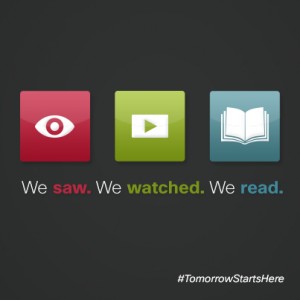I had the opportunity to chat with David Yen a few days ago on a number of topics–one of the things he touched on was how he sees the data center evolving. Now seeing as David is the Senior Vice President and General Manager of our Data Center Group, there are more than just idle musings. Here is a snippet of our conversation:

Omar Sultan: David, you talk about the evolution to an application-defined fabric–from a practical perspective, what does that mean to our customers?
David Yen: We are seeing a shift from a static, IT-controlled environment to a highly dynamic, user-driven environment. The net effect is to bring IT and the business closer together so that is good, but there are some practicalities that need to be addressed in the process. Amon the things we are focused on is making IT easier to consume for app owners and making this dynamic new environment easier to manage for IT.
OS: So, what are we doing to help customers make this transition?
DY: Well, we have been giving them the tools to prepare for this on-demand world for over five years now–our entire Unified DC portfolio—Unified Fabric, Unified Computing and Unified Management –is built around making data center resources flexible and more responsive to quickly changing user demands.
Unified Fabric allows customers to quickly and easily provision network and storage access wherever and whenever they need it. Similarly, UCS Service Profiles allow a UCS server to quickly and automatically adapt to the specific needs of a new workload. We have an entire portfolio of complimentary VM-networking technologies that then ensure there is consistency between the physical and virtual environments. Finally, Unified Management orchestrates, automates, and puts the infrastructure at your fingertips. Today, you can completely configure infrastructure for your apps with a few mouse-clicks. And with Cisco ONE, we are now adding the programmatic interfaces so apps and other systems will be able to directly configure their infrastructure for themselves.
While we have been doing this for a while now, it seems some companies are just catching-up. Recently, we saw a competitor claim leadership in the data center, but if you closely examine their claims, they announced things we have been shipping for a while: cloud-optimized architecture: check, on-demand resources: check, orchestration and management tools: check, L2 Multi-Path: check. Its actually more interesting to note what’s missing—things like network and compute integration, hybrid cloud capabilities, service chaining and multi-hypervisor support. Speeds and feeds are always important, but if that’s all you can talk about, then you are not going to be relevant to today’s conversation.
OS: Where are we going next with the data center fabric?
DY: Looking ahead, there are a couple of areas we will look to address. First of all, while we know that customers are aggressively moving to VM and cloud-based workloads, there is going to be a significant transition period and most enterprise data centers will remain a mix of physical, virtual and cloud workloads and we want to give customers a more comprehensive approach to dealing with this. At the end of the day, the data center should be able to deal with all types of workloads as equal citizens. We don’t have that today in the industry–we have to resort to gateways and other mechanisms to span across physical, virtual and cloud domains–while that’s OK in the interim, its problematic in the long-term.
The other area we will address is increasing operational simplicity. In this dynamic environment, it is neither feasible nor desirable for network operations to be involved in every config change. Ultimately we need to be able to do things at machine speed. You have seen some initial steps in that direction with the Nexus 1000V and its hypervisor integration or new technologies like Power-On Auto Provisioning. Our work with Cisco Open Network Environment has given us the tools and mechanisms to open networks up to facilitate these machine-to-machine or application-to-machine conversations through APIs like onePK and REST and through support of SDN controllers and agents like OpenFlow.
OS: David, why should customers remain confident about Cisco’s vision?
DY: Betting on Cisco is not an act of faith–time and again, we have lead market transitions and delivered the technologies customers need to take advantage of those transitions. We are still, by far, the preferred networking choice, even in the most demanding environments like Massively Scalable DCs, where we are in production for 9 or 10 of the largest providers. We have more than 40,000 NX-OS customers and over 11 million 10GbE ports out there. This gives us unmatched insight into what customers are actually doing and where they are going with their networks. Similarly, we will be delivering VM network solutions across all four major hypervisors, which gives us unmatched breadth of experience in that space. Central to this longevity is avoiding technical blinders. UCS was a great example of our willingness to start off with customer needs in mind. Everything was on the table and that led us to breakthroughs like a brand new operations model based on service profiles. This willingness to risk and lead has translated into to remarkable growth in a very demanding market against a number of capable and entrenched competitors.
As I look at the competition, I see two hurdles they must clear. The first is simply one of simple experience. Its one thing to have a theoretical understanding of a technology and its quite another thing to have actually built and supported it. We have being shipping our Nexus 1000V virtual switch for four years now–we are into third generation functionality like hybrid cloud transport, cloud-based routing services, service chaining and multi-hypervisor support. Compare this to companies that are just getting around to shipping their first virtual switch and will still be working through first generation features and problems.
The second hurdle is a matter of getting caught up in a technical agenda instead of focusing on the customer’s agenda. Software in networking is all the rage right now, for some very good reasons, but you see companies that want to shift all the network functionality into the software because that suits the narrative they want to tell. Now you and I both know, there are some things that absolutely are better handled in software, but, by the same token, there are things are better handled in hardware. We have control over both and that gives us the freedom to put functions where they are best handled. We think that will always give us an advantage over companies that are locked into a particular narrative and must make compromises to support that story.
To hear more from David, and trust me, he has some interesting and entertaining things to say, check out his Solution Keynote on Monday, June 24 at CiscoLive in Orlando.
Share:



CONNECT WITH US